HTC Thunderbolt Review: The First Verizon 4G LTE Smartphone
by Brian Klug on April 27, 2011 12:12 AM EST- Posted in
- Smartphones
- HTC
- Verizon
- LTE
- 4G
- Android
- HTC Thunderbolt
- Mobile
- MDM9600
- MSM8655
So I have a confession to make - I’m late on this one. Way late. I managed to catch strep throat, came down with a high fever, then a sinus infection, and as a result missed my goal of having everything Verizon 4G LTE - including the HTC Thunderbolt - wrapped up and published a few weekends ago. One thing led to the other, and I promised a number of readers both in emails and on Twitter that it would be done a long time before it ended up coming to fruition. I think I’m going to add a week to all time estimations from now on, just to be safe. Apologies if I made you refresh obsessively a few times there.
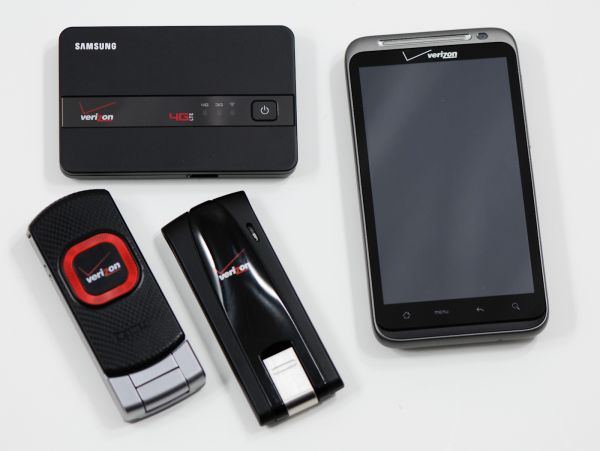
Clockwise from top left: Samsung SCH-LC11, HTC Thunderbolt, Verizon USB551L, Pantech UML290
That said, it isn’t entirely a loss. Over the past month, I somehow have found myself getting slowly buried in literally every single Verizon 4G LTE device (with the exception of the LG VL600 data card) and that’s a good position to be in. The story of our LTE testing started actually before MWC with the Pantech UML290, and since then each time a new device has shown up, I’ve hopped in my car, driven two hours to Phoenix (the nearest LTE market) and spent a sleepless 48 hours testing battery life, speeds, and stability. It’s been a lot of testing, driving, and collecting data. I’ve recorded 542 speed test runs on 4G LTE as a result, and many more on EVDO for comparison. There’s a ton of stuff to go over, so to keep things manageable, I’ve split the review down the middle. This half is HTC Thunderbolt, the other is everything about Verizon 4G LTE from a cellular perspective including two data cards and a WiFi hotspot.
Without any more rambling, let’s get into this review of the first LTE-enabled smartphone on Verizon.
The first thing to say about the HTC Thunderbolt is that it’s gigantic. It’s big simply by virtue of having two transceivers inside, and four antennas. The fact that it’s huge isn’t a bad thing, rather it seems like a smartphone that unblinkingly stares back at legions of notably more superficial smartphones all battling over who is the thinnest (seriously, during CES and MWC several device categories changed thinness crowns in the span of just a few days). It’s almost as if the HTC designers laughed at the trend and boldly designed something different.
I like to think that each section on the site has some insane product that defies reality by being positively huge or defying physics in some manner. Ryan over in GPUs gets to play with his insane AMD 6990 cards and tri-SLI GTX 580s all day. Anand is buried in a house full of 240+ GB SSDs, Jarred and the notebook team does much the same with piles of notebooks, Ganesh with HTPCs, Johan with servers, and so forth. I like to think that the HTC Thunderbolt is in some way analogous to the most insane product in any of those categories, like the 6990 of smartphones, for reasons I’m going to go over in a moment. It’s an exciting smartphone purely because it’s a notable first.
So how is the HTC Thunderbolt? The story of my impressions of this device go all the way back to a Qualcomm meeting at CES when I had hands on with a working version of the phone that had everything but cellular connectivity. Back then, I think the only comment I could mutter at a crowded table surrounded by Qualcomm employees, Vivek, and Anand was - wow, this thing is huge.
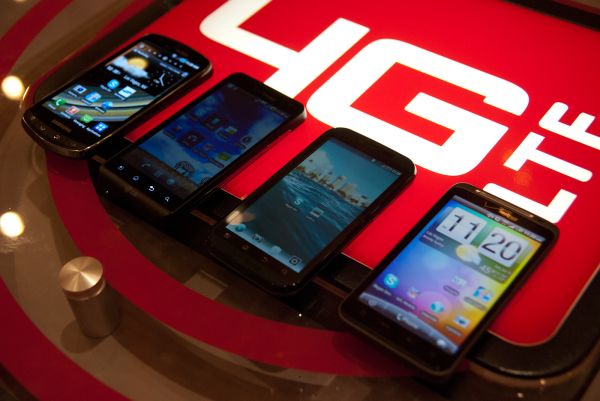
Verizon's 4G LTE Phone Lineup (Left to Right): Samsung Droid Charge, LG Revolution, Motorola Droid Bionic, HTC Thunderbolt
On the last day of CES 2011 I got what would be my last couple of minutes with the Thunderbolt, this time with working cellular connectivity and alongside a crowded lineup of other 4G LTE smartphones launching this year. No speedtests were allowed, just general web browsing. Even at that point, the Thunderbolt was talked about with hushed excitement - this device is furthest along in Verizon’s testing, the rep almost whispered to me. It’ll undoubtedly be the first, if the rest of testing continues as planned. It seemed that everyone knew that the Thunderbolt would be first, and that made it special.
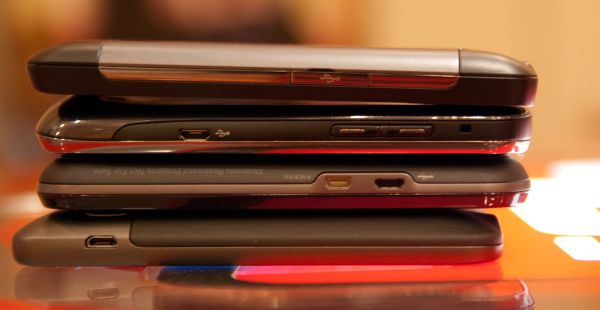
Verizon's 4G LTE Phone Lineup (Top to Bottom): LG Revolution, Samsung Droid Charge, Motorola Droid Bionic, HTC Thunderbolt
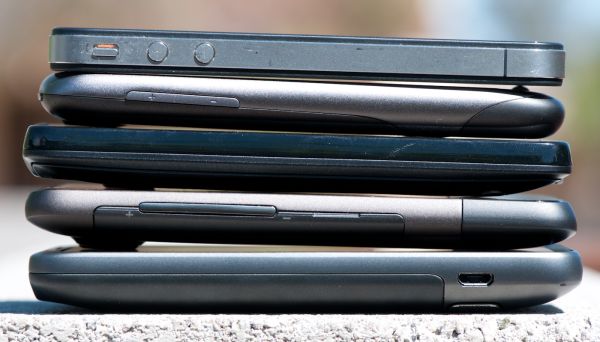
Top to Bottom: iPhone 4, Nexus One, HTC EVO, HTC Inspire, HTC Thunderbolt
The handset itself has a dominant full-hand feel, with good ergonomics. Thickness is where the Thunderbolt is really an outlier, at 13.2 mm, it’s considerably thicker than most of what else is launching lately. In the mass department as well, the Thunderbolt is specced at 173 grams with battery, though I measured 183.3 grams on my balance. As an aside, verifying size and mass is going to be another thing we’re doing going forward, especially after some notable specification confusion from back when I tackled the Fascinate.
Whether the Thunderbolt is simply too chunky depends on your hands and pockets, but there’s no denying that it’s large. Toss in the official double capacity battery which adds a square protrusion to the back, and it’s even larger. Again, simply by virtue of having a 4.3 inch screen, two cellular basebands and being stuffed full of antennas, the phone is going to be larger than average.


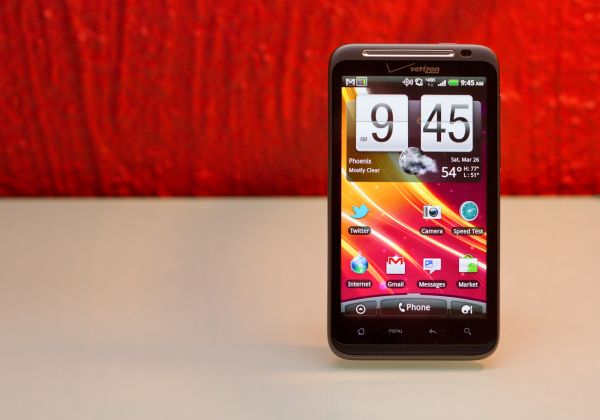
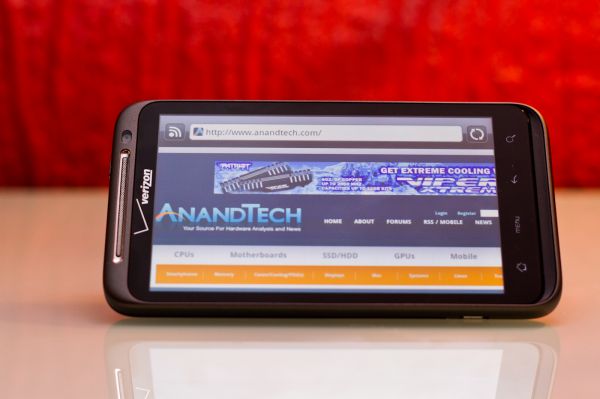














71 Comments
View All Comments
HangFire - Wednesday, April 27, 2011 - link
I credit this to Angry Birds. The bigger the tablet, the better the experience.MilwaukeeMike - Wednesday, April 27, 2011 - link
Well... it comes with a kickstand, clearly they want us to watch movies on them, which means they're not going to get any smaller. Have you ever had one though? It's not that bad. I have a double sized battery on my EVO and the extra width actually makes it easier to take out of my pocket (The ridge by the kickstand makes a little 'handle') and easier to hold sideways.MilwaukeeMike - Wednesday, April 27, 2011 - link
Oh... and a thicker phone means it's more likely in contact with your leg (guys) if in your pocket and increases the chance that you'll feel it when on vibrate.HangFire - Wednesday, April 27, 2011 - link
Brian, great in-depth review.The original Tbolt specs had 8GB of NAND Flash, but mine only reads 4. I've heard a rumor the that half was locked out to help deal with the battery issue, and another rumor that it might be "unlocked" some day. Do you have any info?
Also, some mention should be made of the awful Blockbuster app that comes pre-installed, with permissions to spy on everything, running processes that constantly use data, and cannot be uninstalled short of rooting. HTC and Verizon should be made to understand that such shovelware/crapware is totally unacceptable.
I found the 5MP T-Mobile G2 camera much better indoors/low-light than my Tbolt. Alas, T-Mobile has poor data in my area so I moved over to Verizon and the Tbolt. I think the pointless increase in Megapixels is the cause. I'd like to see better pictures, not better specs.
Brian Klug - Wednesday, April 27, 2011 - link
Interesting, I went with the HTC specifications which list 8 GB, but see what you mean about 4 GB now on this Thunderbolt. Very curious. I don't think the reason could be battery usage since it's nonvolatile, though I've heard lots of discussion about devices with 1 GB+ of RAM using more battery. I'll ask some questions and find out.The funny part about the crapware on the Thunderbolt is that it's actually far less than I see on the Inspire 4G. I haven't seen the Blockbuster app be persistent (though that could be because I haven't launched it), but otherwise yes you're completely right about the preload situation.
-Brian
sooper_anandtech12 - Wednesday, April 27, 2011 - link
Nice to see that the 3.7" 854x480 display on the Droid and Droid 2 still rockin' it as one of THE best displays in the mobile space. As for the push towards qHD displays. To be honest, I would like Motorola and the rest of them to hold off on these qHD displays. They all employ PenTile pixel substructures which effectively means there are less pixels than advertised. Looking at an Atrix display compared to my Droid's display and it's clear the Atrix should have been called Atrocious. The pixelation around widgets and on wallpapers was unacceptable. I haven't seen pixelation like that since AMOLED. Why release qHD PenTile LCDs when Samsung recently admitted PenTile stinks and is going with a normal RGB set up with S-AMOLED+? I'd rather see a nice IPS display like in the LG G2X, running at the antiquated 800x480 than a qHD display running 30% less pixels than the 960x540 that's advertised.mlosee222 - Wednesday, April 27, 2011 - link
Confirmed by threads at xda developers and other sources:http://www.engadget.com/2011/04/27/verizons-lte-ne...
Maybe its just the verizon commercials, but what has me sold is the network. I could honestly care less about the phone compared to the speeds LTE offers. Voice is a secondary consideration to data throughput for me. I would buy the thunderbolt for the network alone.
With that being said, I sincerely hope verizon's LTE isn't as overloaded and useless as T-Mobile's "3G" network is.
hans007 - Wednesday, April 27, 2011 - link
i agree. as someone who just left t-mobile for verizon, their network is terrible now at least for data. their voice isn't really spectacular either.in the bay area, their 3G coverage was really spotty.
and i am also in los angeles a lot and t-mobile has a ton of dead zones. i can't believe they advertise it as 4G as it felt slower than 3G on verizon.
Brian Klug - Wednesday, April 27, 2011 - link
It's a bitter irony really, of course the day after I post everything, eHRPD goes down and takes 4G LTE and 3G EVDO (on eHRPD) with it.If you go into EPST (##778#) and enter MSL (000000), you can change the modem setting under Rev.A to use just HRPD instead of eHRPD. That way, you're anchored through the old 3G data network instead of the common anchor point for EVDO and LTE that appears to be having problems right now.
I've been having sporadic EVDO (eHRPD) connectivity all day with dips to 1x. Unfortunate, but things like this will gradually get better in time.
-Brian
synaesthetic - Thursday, April 28, 2011 - link
Really depends on where you live, and plus you also get what you pay for. T-Mobile is considerably cheaper than Verizon.For slightly less service (assuming I do not buy an LTE device), Verizon charges me $30 more than T-Mobile does. From $65 to $95 for almost exactly the same service (though I lose 50 minutes of anytime minutes on Verizon).
Considering the uncertain future of T-Mobile US, I am considering Verizon as an option, but to me the device--and more specifically, the ROM--is the most important thing as long as my network speeds are decent enough.
For the record, my T-Mobile HSPA+ in downtown Berkeley is excellent, usually 6-7Mbps down and 2-3Mbps up. Absolutely sufficient for my purposes. At home, yeah, in the 'burbs my data speed kind of bites... but I have wifi and much faster wired broadband, why would I bother with using my data plan at home? :D